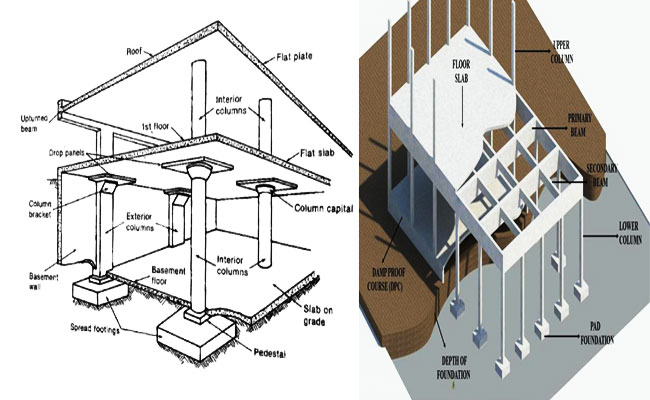Various components found in reinforced concrete building

Given below, the details of Elements of a Reinforced Concrete Building
1st Floor
It is the floor that contains 1 storey height over ground.
Basement Floor
The floor associated with the basement of the building. It is also known as cellar. The basement floor is located either entirely or partly underneath the ground floor. A basement is utilized absolutely as similar way like a supplementary above-ground floor of a building or other building. The basements can be utilized mainly on the basis of various factors found in certain geographical area like climate, soil, seismic activity, building technology, and real estate economics.
The concrete floor in nearly all basements is structurally not included in the foundation; exclusive of basement walls. Normally, the basements are cooler as compared to the rest of the house to cope up with hot air. So, basements become dampen in summer, because of the greater relative humidity.
Basement Wall
The wall that encircles the basement floor is known as the basement wall. The basement walls are structurally considered as inherent portion of the foundation. The basement walls refer to shear walls which can also withstand lateral loads. Besides, these walls are treated as extremely non-porous and water defiant.
Column Bracket
Column Bracket is protrusion from the column and lamps, bulbs and other accessories can be affixed or hanged by it.
Column Capital
Column capital belongs to an architectural element that is applied for aesthetic purposes to build up the uppermost member of a column.
Drop Panels
The application of drop panels is found to solidify the slab all over the column in flat slabs to resist punching shear. As flat slabs do not contain stirrups, shear is controlled by solidifying the slab around the column to improve the concrete strength in shear. Beams are also utilized, but normally drop panels are chosen to get rid of conflicts with the electro-mechanical works of the structure.
Exterior Columns
Exterior columns stand for the columns which support the primary structure of the building. The exterior columns play an important role in frame structures because they sustain the load of the building and combat various ecological factors like wind, rain, and other physical factors.
Flat Plate
Flat plate belongs to the slabs which are attached to the columns directly. Flat plate system is mostly recognized by the engineers because of its various benefits. The system can curtail the height of the building, creates more compliant spatial planning as there are no beams, as well as minimize the material cost. But, the major issue is the breakable failure of flat plate against punching shear. Flat plate construction is becoming popular because of comparatively small floor loading and the close column spacing. Waffle slabs are applied for greater loading and bigger column spacing, and for even greater spacing to decrease the self-weight.
To gather more information, click on the following link.
www.aboutcivil.org

Image Courtesy : www.aboutcivil.org
